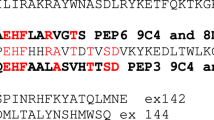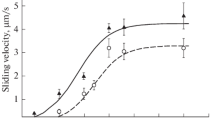Summary
We have found evidence for two beta-like myosin heavy chains in humans, one cardiac and one skeletal. The cDNA sequences of the cardiac beta myosin heavy chain cDNA clone pHMC3 and the skeletal beta-like myosin heavy chain cDNA clone pSMHCZ, were compared to each other. It was found that the 3′ untranslated regions as well as 482 nucleotides specifying the carboxyl coding region, were 100% homologous. Further examination revealed that the skeletal clone pSMHCZ diverges from the human cardiac beta myosin heavy chain cDNA clone pHMC3 at the 5′ end. We present evidence in this report which indicates that the cardiac beta myosin heavy chain mRNA is expressed in skeletal muscle tissues. The human cardiac beta myosin heavy chain cDNA clone, pHMC3, which codes for a portion of the light meromyosin section of the myosin heavy chain, was used as a probe for S1 nuclease mapping studies with RNA derived from cardiac tissue, smooth muscle and skeletal muscle tissues consisting of fast-twitch, slow-twitch and mixed fast- and slow-twitch muscle fibres. Two probes were used to examine the expression of the mRNA. One probe (406 nucleotides) constitutes the 3′ untranslated region and a portion of the coding region of the beta cardiac myosin heavy chain cDNA clone, which is 100% homologous to pSMHCZ, the skeletal cDNA clone. The other constitutes the majority of the coding region (1017 nucleotides) of the cardiac clone pHMC3 in which the first 216 nucleotides from the labelled end are 100% homologous to the skeletal clone pSMHCZ. In the soleus muscle, which is rich in slow-twitch type I muscle fibres, the expression of the cardiac beta myosin heavy chain mRNA was very prominent. In gastrocnemius muscle, a mixed fibre muscle, the expression of this mRNA was detected to a lesser degree than that for the soleus muscle. In vastus lateralis and vastus medialis, which consist of predominantly type II, fast-twitch fibres, there were trace amounts of the cardiac beta myosin heavy chain mRNA. When expression of this mRNA was tested in smooth muscle tissue none could be detected.
Similar content being viewed by others
References
Banerjee SK, Wiener J (1983) Effects of aging on atrial and ventricular human myosin. Basic Res Cardiol 78:685–694
Bernstein SI, Mogami K, Donady JJ, Emerson CP (1983) Drosophila muscle myosin heavy chain encoded by a single gene in a cluster of muscle mutations. Nature 302:393–397
Cummins P (1982) Transitions in human atrial and ventricular myosin light-chain isozymes in response to cardiac pressure overload induced hypertrophy. Biochem J 205:195–204
Edwards YH, Parkar M, Povey S, West LF, Parrington JM, Soloman E (1985) Human myosin heavy chain genes assigned to chromosome 17 using a human cDNA clone as a probe. Ann Hum Genet 49:101–109
Hirzel HO, Tuchschmid CR, Schneider J, Krayenbuehl HP, Schaub MC (1985) Relationship between myosin isozymes composition, hemodynamics, and myocardial structure in various forms of human cardiac hyperthrophy. Circ Res 57:729–740
Hoh J, McGrath P, Wale P (1978) Electrophoretic analysis of multiple forms of rat cardiac myosin: effects of hypophysectomy. J Mol Cell Cardiol 10:1053–1076
Hoh J, Yeoh G, Thomas M, Higgenbottom L (1979) Structural differences in the heavy chains of rat ventricular myosin isozymes. FEBS Lett 97:330–334
Jandreski MA, Liew CC (1984) Characterization of neonatal cardiac myosin heavy chain mRNA and synthesis of complementary DNA. Can J Biochem Cell Biol 62:185–190
Jandreski MA, Liew CC (1987) Construction of a human ventricular cDNA library and characterization of a beta myosin heavy chain cDNA clone. Hum Genet 76:47–53
Johnson MA, Polgar J, Weightman D, Appleton D (1973) Data on the distribution of fibre types in thirty-six human muscles: an autopsy study. J Neurol Sci 18:111–129
Leinwand LA, Saez L, McNally E, Nadal-Ginard B (1983a) Isolation and characterization of human myosin heavy chain genes. Proc Natl Acad Sci USA 80:3716–3720
Leinwand LA, Fournier REK, Nadal-Ginard B, Shows TB (1983b) Multigene family for sarcomeric myosin heavy chain in mouse and human DNA: localization on a single chromosome. Science 221: 766–769
Lompre A, Mercardier JJ, Wisnewsky C, Bouveret P, Panataloni C, D'Albis A, Schwartz K (1981) Species and age dependent changes in relative amounts of cardiac myosin isozymes in mammals. Dev Biol 84:286–290
Lompre A, Nadal-Ginard B, Mahdavi V (1984) Expression of the cardiac ventricular alpha and beta myosin heavy chain genes is developmentally and hormonally regulated. J Biol Chem 259:6437–6446
Mahdavi V, Periasamy M, Nadal-Ginard B (1982) Molecular characterization of two myosin heavy chain genes expressed in the adult heart. Nature 297:659–665
Maniatis T, Fritsch EF, Sambrook J (eds) (1982) Molecular cloning: a laboratory manual. Cold Spring Harbor Laboratory, Cold Spring Harbor, NY
Maxam A, Gilbert W (1980) Sequencing end-labelled DNA with base specific chemical cleavage. Methods Enzymol 65:499–560
Mercardier JJ, Bouveret P, Gorza L, Schiaffino S, Clark WA, Zak R, Swynghedauw B, Schwartz K (1983) Myosin isozymes in normal and hypertrophied human ventricular myocardium. Circ Res 53: 52–62
Orkin SH, Goff SC (1981) The duplicated human alpha globin genes: their relative expression as measured by RNA analysis. Cell 24: 345–351
Polgar J, Johnson MA, Weightman D, Appleton D (1973) Data on fibre size in thirty-six human muscles. An autopsy study. J Neurol Sci 19:307–318
Rappold GA, Vosberg HP (1983) Chromosomal localization of a human myosin heavy-chain gene by in situ hybridization. Hum Genet 65:195–197
Rozek CE, Davidson N (1983) Drosophila has one myosin heavychain gene with three developmentally regulated transcripts. Cell 32:23–34
Saez L, Leinwand LA (1986) Characterization of diverse forms of myosin heavy chain expressed in adult human skeletal muscle. Nucleic Acids Res 14:2951–2969
Schier JJ, Adelstein RS (1982) Structural and enzymatic comparison of human cardiac muscle myosins isolated from infants, adults and patients with hypertrophic cardiomyopathy. J Clin Invest 69:816–825
Sinha AM, Friedman DJ, Nigro JM, Jakovcic S, Rabinowitz M, Umeda PK (1984) Expression of rabbit ventricular alpha-myosin heavy chain messenger RNA sequences in atrial muscle. J Biol Chem 259:6674–6680
Author information
Authors and Affiliations
Rights and permissions
About this article
Cite this article
Jandreski, M.A., Sole, M.J. & Liew, CC. Two different forms of beta myosin heavy chain are expressed in human striated muscle. Hum Genet 77, 127–131 (1987). https://doi.org/10.1007/BF00272378
Received:
Revised:
Issue Date:
DOI: https://doi.org/10.1007/BF00272378




